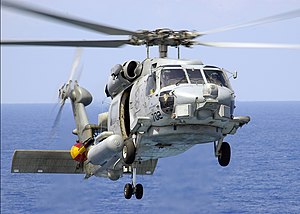| SH-60 / HH-60H / MH-60 Seahawk | |
|---|---|
 A U.S. Navy SH-60B Seahawk landing on USS Abraham Lincoln | |
| General information | |
| Type | Utility maritime helicopter |
| National origin | United States |
| Manufacturer | Sikorsky Aircraft |
| Status | In service |
| Primary users | United States Navy |
| Number built | 938[1][2] |
| History | |
| Manufactured | 1979–present |
| Introduction date | 1984 |
| First flight | 12 December 1979 |
| Developed from | Sikorsky UH-60 Black Hawk |
| Variants | Sikorsky MH-60 Jayhawk Mitsubishi SH-60 Piasecki X-49 |
The Sikorsky SH-60/MH-60 Seahawk (or Sea Hawk) is a twin turboshaft engine, multi-mission United States Navy helicopter based on the United States Army UH-60 Black Hawk and a member of the Sikorsky S-70 family. The most significant modifications are the folding main rotor blades and a hinged tail to reduce its footprint aboard ships.
The U.S. Navy acquired H-60 helicopters under the model designations SH-60B, SH-60F, HH-60H, MH-60R, and MH-60S. Able to deploy aboard any air-capable frigate, destroyer, cruiser, fast combat support ship, expeditionary transfer dock, amphibious assault ship, littoral combat ship or aircraft carrier, the Seahawk can handle anti-submarine warfare (ASW), anti-surface warfare (ASUW), naval special warfare (NSW) insertion, search and rescue (SAR), combat search and rescue (CSAR), vertical replenishment (VERTREP), and medical evacuation (MEDEVAC). When entering service, the SH-60 was too large to operate from some of the smaller vessels in service, so it served along with the Kaman SH-2F and SH-2G models until 2001.
Early model Seahawks began to be retired in the 2010s and 2020s, with the last B model leaving U.S. Navy service in 2015, after over three decades, then the F and H models followed in 2016. These were replaced by the upgraded MH-60R and S models.